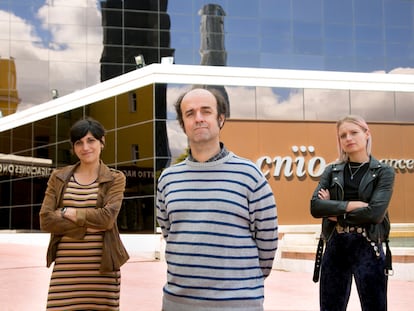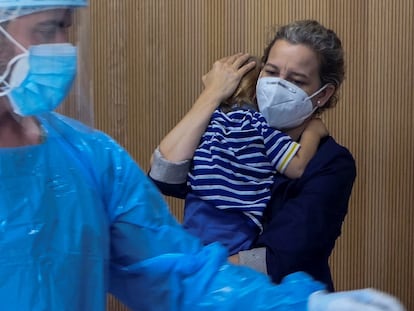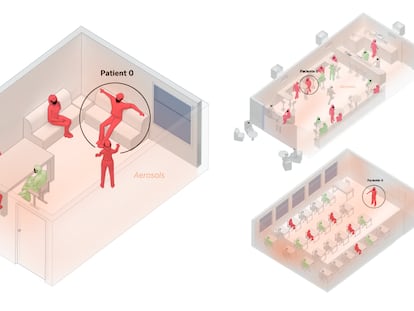The coffee chat that shed light on one of the world’s most devastating diseases
Spanish scientist Óscar Fernández Capetillo discovered a mechanism underlying amyotrophic lateral sclerosis (ALS) following a casual talk with a US Nobel prize winner

In 2016, a Spanish biochemist named Óscar Fernández Capetillo attended a conference about the origins of life on Earth. The speaker was Jack W. Szostak, a winner of the Nobel Prize for Physiology or Medicine, who was attempting to discover the recipe for generating life in the laboratory, from a basis of chemical ingredients already present on the planet during the Earth’s infancy. After his talk, both men got together for coffee. Szostak does not remember the content of their conversation but for Fernández Capetillo it is imprinted on his memory. Five years later, that brief chat has culminated in the discovery of a mechanism that sheds light on one of the most devastating diseases known to humans: amyotrophic lateral sclerosis (ALS, also known as Lou Gehrig’s disease).
The disorder, which sooner or later proves fatal, affects one in every 20,000 people in the world. ALS tends to appear without warning in adults, destroying the nerve cells that control muscle movement, gradually leaving the patient unable to walk, talk, eat and, finally, to breathe. There is no cure. And, in 90% of cases, the cause is unknown.
Fernández Capetillo, 46, of the Madrid-based Spanish National Cancer Research Center (CNIO), first took an interest in ALS in 2014, when the famous Ice Bucket Challenge campaign in which celebrities, including Donald Trump, would record themselves tipping a bucket of iced water over their heads, was launched to draw attention to the disease.
Fernández Capetillo was at that time a world-renowned expert in cancer. The scientific journal Cell had just included him in an international selection of 40 principal investigators under the age of 40. After developing an experimental cancer drug and seeing it licensed in 2013 by the pharmaceutical company Merck Serono, Fernández Capetillo turned his attention to ALS. “I believed that, with the tools we had at our disposal for cancer research, we could make progress with ALS,” he recalls.
His eureka moment came on April 14, 2016. Szostak was giving a talk at the Karolinska Institute in Stockholm, where Fernández Capetillo also has his own laboratory. The Spaniard recalls that, during their coffee conversation, Szostak told him about his experiments to try and recreate the origins of human life. The American researcher’s hypothesis was that life on Earth emerged through ribonucleic acid (RNA), a sugar and phosphate-based molecule that directs human cells to form proteins, such as hemoglobin in the blood and myosin in the muscles. Szostak explained to Fernández Capetillo that in order to slow down chemical reactions in the laboratory, he used small proteins rich in arginine, a molecule that sticks to RNA and DNA like glue.

Suddenly, Fernández Capetillo’s mind segued from the origin of life on Earth to ALS. “I thought to myself: ‘Wow, what if the same thing is happening with ALS patients.’ And that is exactly what was happening. This was the mechanism that causes neurons to be killed off,” he says. The results of his investigations were published on May 12 in the specialized publication The EMBO Journal, co-authored by CNIO researchers Vanesa Lafarga and Oleksandra Sirozh.
Around 10% of ALS patients also have family members who suffer from the disease. Fernández Capetillo and his team have focused on these cases where there is a genetic component, half of which are connected to the C9ORF72 gene. The researchers have observed that mutations in this gene induce human cells to produce small proteins that are rich in arginine, which stick to RNA and DNA, blocking essential cellular processes and killing off neurons in ALS patients. Fernández Capetillo believes that the mechanism could be similar in others types of ALS. “I don’t know if it can be extrapolated to all of them, but to a large number, yes,” he says.
Szostak has not spoken to Fernández Capetillo since their brief conversation in 2016. Speaking to EL PAÍS, the Harvard University researcher was staggered by the results with ALS: “It’s extraordinary that a trivial comment over coffee can lead to such interesting experiments years later!”
Valle Palomo, a chemist at the Spanish National Research Council (CSIC), has applauded Fernández Capetillo’s work: “It is a huge step forward toward understanding why this disease affects these patients in particular.” But Palomo, who runs a project to seek treatments for ALS, sounds a note of caution by pointing out that 90% of ALS diagnoses do not display any genetic component. “What happens with the patients where we have not detected any mutation? We will have to see if something similar occurs or if there are more mechanisms involved. This is the big question.”
Ana Martínez Gil, also a CSIC expert in chemistry, runs ALS-Madrid, another project dedicated to developing experimental treatments against the disease. She also lauds Fernández Capetillo’s research but adds she would have liked a more in-depth analysis of the results, such as the possible relation between this new mechanism and the appearance of TDP-43 protein aggregates in neurons, a phenomenon considered a distinctive hallmark of the disease. “Each one of us is focused on a single path and we are incapable of lifting our heads for a moment to see what is happening at the general level: how the different roads join up,” say Martínez Gil.
Despite that, Martínez Gil is optimistic. “ALS used to be a hidden disease and in the last few years it has been made visible. It was a disease that was invisible to society, to researchers, to doctors and to those who finance investigation,” she says. “Now that it has been made visible, lots of human and financial resources are being focused on it. And whenever resources are allotted, in the long term there will be results.”
Fernández Capetillo and his team have started to look for potential therapies for ALS in mice that have been genetically modified to produce large amounts of small proteins containing arginine. “The key to curing any disease is to first understand what is not working,” he says. “Only in this way can you start to look for a cure.”
English version by Rob Train.
Tu suscripción se está usando en otro dispositivo
¿Quieres añadir otro usuario a tu suscripción?
Si continúas leyendo en este dispositivo, no se podrá leer en el otro.
FlechaTu suscripción se está usando en otro dispositivo y solo puedes acceder a EL PAÍS desde un dispositivo a la vez.
Si quieres compartir tu cuenta, cambia tu suscripción a la modalidad Premium, así podrás añadir otro usuario. Cada uno accederá con su propia cuenta de email, lo que os permitirá personalizar vuestra experiencia en EL PAÍS.
¿Tienes una suscripción de empresa? Accede aquí para contratar más cuentas.
En el caso de no saber quién está usando tu cuenta, te recomendamos cambiar tu contraseña aquí.
Si decides continuar compartiendo tu cuenta, este mensaje se mostrará en tu dispositivo y en el de la otra persona que está usando tu cuenta de forma indefinida, afectando a tu experiencia de lectura. Puedes consultar aquí los términos y condiciones de la suscripción digital.
More information
Archived In
Últimas noticias
Most viewed
- Reinhard Genzel, Nobel laureate in physics: ‘One-minute videos will never give you the truth’
- Oona Chaplin: ‘I told James Cameron that I was living in a treehouse and starting a permaculture project with a friend’
- Pablo Escobar’s hippos: A serious environmental problem, 40 years on
- Charles Dubouloz, mountaineering star, retires at 36 with a farewell tour inspired by Walter Bonatti
- Why we lost the habit of sleeping in two segments and how that changed our sense of time











































